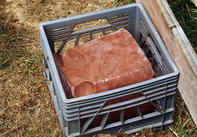Goats are versatile in selecting their food, and where suitable bushes and trees are available, they will prefer to browse. For this reason, in many parts of the world, fodder trees are cultivated, such as Leucaena leucocephala known in South Africa as the lead tree, white popinac, reusewattel or stuipboom (Afrikaans) and ubobo; ulusina (isiZulu).

This tree is considered an invasive species in South Africa and is often found along streams. Dairy goats are different from other breeds of goats and cannot be productive when they have only natural vegetation such as veld grazing to eat. The main objective of feeding dairy goats should be to supply all the nutrients required in the correct amounts and proportions at the least cost.
Feeds should also taste good so that the goats will eat enough and should contain essential nutrients - energy, protein, minerals, vitamins and water. Dairy goats have to produce milk efficiently and they must be fed properly if they are to achieve their potential.
Any additional activity, such as walking, growing, pregnancy or milk production means that it will have extra requirements in addition to their normal body maintenance. Nutritional needs of dairy goats are different while they are pregnant than from after they have given birth. For best management, divide the goat herd into production groups.
Feeding Dry Goats
A dry (non-lactating) goat will probably not need much more than good quality roughages unless she is thin or in her last month of pregnancy. Ewes that increase mass at mating are more inclined to produce twins than those who maintain their weight or lose weight.Nutritional Needs of a Pregnant Goat
In the six weeks before birth, the doe’s udder needs to rest and milk tissue needs to be rejuvenated. About 70% of the baby goat’s development takes place in the 6 weeks prior to kidding.
Feed enough energy in the last month of pregnancy when the unborn kids inside the uterus are making big demands on their mother’s metabolism. If there is not enough energy in the diet at that time, then fat reserves will be mobilized. But if the demand is too great, the liver may not be able to cope, and the goat may die from a condition known as ketosis (“pregnancy toxaemia”).
The ideal body condition score fo a pregnant goat should be 2.5 to 3. When a goat is pregnant with twins, she will be limited to the amount of feed that she can eat. A high-quality and tasty diet with sufficient good quality roughage is needed during this time.
Nutritional Needs of a Lactating Goat

For every 3 litres of milk produced, a lactating goat requires about 1.5 kg of good quality hay plus 500 g of hay for maintenance, plus 1 kg of concentrate. If dairy goats are grazing (browsing) they should consume at least 4 to 6 kg of good quality forage per day - 4 kg green forage is equal to 1 kg hay.
Lactating dairy goats will need a concentrate with an average protein content of 15 - 17% with the total digestible nutrients (TDN) of the concentrate around 65 - 75%. If does are fed with a complete ration, hay and straw should be available at all times. Good quality roughages should be fed to lactating goats so that the amount of expensive dairy meal needed will be as little as possible.
In general, roughage should contribute 40% to 60% of the daily dry matter intake (DMI) for lactating goats. For example, a high-yielding goat giving 4 litres of milk a day might eat a total of 3 kg dry matter (DM), of which 1.2 kg DM (40%) might be in the form of lucerne hay, and 1.8 kg DM in the form of a dairy meal.
Both the lucerne and the dairy meal will be about 90% DM, so that the actual quantities fed would be: lucerne hay: 1.2 x 100 = 1.3 kg and dairy meal: 1.8 x 100 = 2.0 kg If the lucerne is fresh (not hay), the dry matter of the lucerne might have been 24%, in which case the amount of lucerne to feed (to get the same DMI of roughage) would be: 1.2 x 100 = 5 kg.
Please note: Information is for educational and informational purposes only and may not be construed as feeding or nutritional advice. For more information on feeding your animals contact your animal health technician, veterinarian or animal feed supplier.
By Marinda Louw